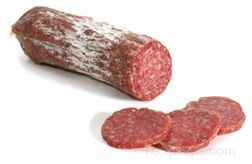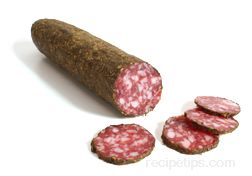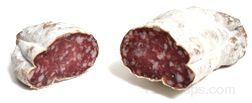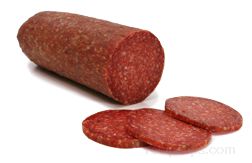Similar Content to: Milano Salami

As the Salami matures, the coarse and dry texture of the meat typically develops a deeper red coloring. The color can be more intense in some varieties than others as displayed in some lighter colored varieties of Salami, such as Cervelat. Most often, Salami will have a deep red to burgundy color with specks of pink or white fat mixed with white or black peppercorns. The aroma is somewhat intense, while the flavor is mild to spicy with a slight saltiness. As the Salami ages, some of the moisture is lost and the meat becomes harder in texture. If it becomes too hard, it has lost too much moisture and most likely its true flavor as well.
There are a variety of Salami shapes, sizes, and types. Genoa, with white peppercorns, and Cotto, with black peppercorns, are two of the most common varieties. Genoa is traditionally made of pork and veal, which is seasoned with garlic, pepper, and wine. Cotto is made of pork and beef, which is flavored with garlic and peppercorns. Cervelat, which is another member of the dry sausage family is a semi-dry Salami that is not as coarse or dry as traditional varieties of Salami. Other varieties of Salami include Danish, French, German, Italian, each with slightly different ingredients and flavors. Italian Salami, which are very dense, are commonly named for the type or region providing the Salami recipe, such as Fiorentino, Milano, Naopli, Sardo, Toscano, and Ungherese Salami.
In years past, it was traditional to use only natural (animal) casings that were hand tied after packing and allowed to mold as the Salami cured. When this occurs, the outside of the casing becomes covered in a non-harmful, white powder, similar to the process of curing various cheeses. The mold creates enzymes that react with the meat to tenderize and flavor the ingredients. The large intenstine which was fat and quite thick provided an excellent casing for the larger sticks or logs of Salami that required more time to age and season. The smaller intestines were used for the smaller-sized sticks of Salami and the colon was used for very short sticks of Salami, often referred to as chub Salami. Meats packed in the colon, which was irregularly-shaped, are typically referred to as crespone or crespo sausages, such as crespone Salami.
Salami can be stored for long periods of time. If the casing has not been cut, it can be kept unrefrigerated. After the casing is cut, the salami should be refrigerated and can be kept for several weeks before becoming too dry for use. When serving Salami, allow the meat to warm to room temperature in order to provide the most flavor. Sliced Salami, which is refrigerated to preserve it, begins to loose its true flavor after 2 to 3 days.










